Balbharti Maharashtra State Board Class 10 Geography Solutions Chapter 8 Economy and Occupations Notes, Textbook Exercise Important Questions and Answers.
Std 10 Geography Chapter 8 Question Answer Economy and Occupations Maharashtra Board
Class 10 Geography Chapter 8 Economy and Occupations Question Answer Maharashtra Board
Geography Class 10 Chapter 8 Question Answer Maharashtra Board
1. Fill in the blank with appropriate word.
Question a.
India’s per capita income is less than Brazil due to _______.
(a) low national income
(b) massive population
(c) big family size
(d) low foodgrain production
Answer:
(b) massive population
![]()
Question b.
The economy of Brazil is mainly dependent on ______ the activities.
(a) primary
(b) secondary
(c) tertiary
(d) quaternary
Answer:
(c) tertiary
Question c.
The economics of India and Brazil are of the _____ type
(a) undeveloped
(b) developed
(c) developing
(d) highly developed
Answer:
(c) developing
2. Answer the following questions:
Question a.
Why has mining not developed in the western part of Brazil?
Answer:
(i) Most of the western part of Brazil is covered by the thick dense equatorial rainforests of the Amazon Basin.
(ii) Inaccessibility, poor transport links, unfavourable climate, heavy rainfall are the main barriers for mining in this part.
(iii) Moreover, lack of knowledge of potential reserves of resources is the other factor which has led to limitations in mining in the western part of Brazil.
(iv) Therefore, mining is not developed in the western part of Brazil.
Question b.
What are the similarities and differences in the fishing activities in Brazil and India.
Answer:
Similarities:
- In Brazil and India fishing activity is developed near the coastal areas.
- In both the countries, marine fishing is well- developed.
Differences:
- In India, fresh water fishing is practised, whereas in Brazil due to unfavourable conditions, fresh water fishing is not developed.
- The meeting of the warm Brazil current and the cold Falkland current, off the coast of South-East Brazil makes it a good fishing ground. In India such currents do not come together but due to other favourable conditions fishing has been developed.
- Major fishes of Brazil are swordfish, shrimp, lobsters and sardines.
- Major fishes of India are mackerel, bombay duck, prawns, horse mackerels, clupeids, silver bellies and sardines.
![]()
3. Give reasons:
Question a.
Per capita land availability is more in Brazil as compared to India.
Answer:
- India occupies 2.4% land area of the world and supports 17.5% of the world’s total population.
- Brazil occupies 5.6% of land area of the world and supports only 2.75% of the world’s total population.
- Average density of population in India is about 382 persons per sq. km. while average density of population in Brazil is around 23 persons per sq. km.
- Thus Brazil’s population is lesser than India, but it occupies a larger land area than India.
- So, the per capita land availability is more in Brazil as compared to India.
Question b.
There is mixed economy in Brazil and India.
Answer:
- In a mixed economy there is a co-existence of public sector and private sector.
- In Brazil, sectors like health, banking, telecommunications, railways and airways are owned and managed by both public and private sectors.
- In India railways is largely a public sector whereas all the other sectors are owned and managed by both private and public sectors.
- So it is said that there is a mixed economy in Brazil and India.
4. Study the following graph and analyse in short.
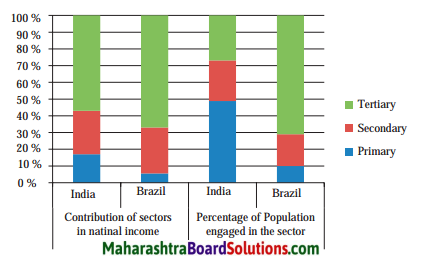
Answer:
(i) This is a compound bar graph showing the contribution of primary, secondary and tertiary sectors to the national income of India and Brazil.
(ii) It also shows the percentage of population engaged in these sectors.
(iii) The contribution of primary, secondary and tertiary sector to India’s national income is about 17%, 26% and 57% respectively.
(iv) Whereas the contribution of primary, secondary and tertiary sector to Brazil’s national income is about 5%, 28% and 67% respectively.
(v) The population engaged in primary, secondary and tertiary sector of India is about 49% 24% and 27% respectively.
(vi) The population engaged in primary, secondary and tertiary sector of Brazil is about 10%, 19% and 71% respectively.
(vii) Thus it is understood clearly from the graph that Brazil is not an agrarian economy like India.
Class 10 Geography Chapter 8 Economy and Occupations Intext Questions and Answers
Give It a Try
Read the following graph and answer the following questions:
Gross National Incomes (GNI) from 1960 to 2016 (in million US. $)
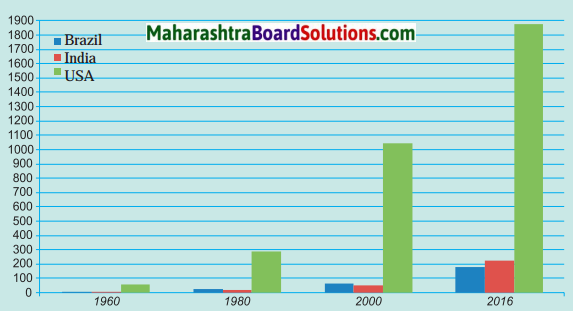
Question 1.
Which country’s national income was the highest in 2016 and how much was it?
Answer:
USA’s national income was highest in 2016. It was approx. U.S. $ 18000 million.
Question 2.
Comparing India and Brazil, which country had a higher national income in 1980?
Answer:
Brazil had a higher national income in 1980, as compared to India.
Question 3.
Comparing India and Brazil, which country had a higher national income in 2016?
Answer:
Comparing India and Brazil, India had a higher national income.in 2016.
Question 4.
Tell the difference between the GNP of Brazil and India in 2016.
Answer:
The difference between the GNP of Brazil and India in 2016 is approximately US $ 300 million. (India : $ 2000 million – Brazil: $ 1700 million)
Question 5.
Name the developing and developed economies based on the graph?
Answer:
India and Brazil are developing economies and the USA is a developed economy.
Question 6.
Calculate the difference between the national incomes of developed and developing countries , in 2016.
Answer:
The difference between the national incomes of developed and developing countries in 2016 was nearly U.S. $ 16500 million.
(US: $18500 million – India, Brazil: $ 2000 million)
Try this
Question 1.
A table regarding the ownership of various sectors in both the countries is given. Like Brazil, fill the details regarding India and complete the table.
Answer:
| S.No | India | Sector | Brazil |
| (1) | Private and Public both | Banking | Private and public both |
| (2) | Largely Public | Railways | Private and public both |
| (3) | Largely Private Little Public | Airways | Private and public both |
| (4) | Private and Public both | Electricity production | Largely public |
| (5) | Private and Public both | Iron and Steel Industry | Largely public |
| (6) | Private and Public both | Health | Private and public both |
| (7) | Largely Private and Public | Education | Largely public, little private |
| (8) | Largely Private and little Public | Telecomm unications | Private and public both |
![]()
Let’s Recall
Question 1.
Classify the following activities by ticking ( ✓ ) in the respective column
Answer:
| S.No | Activities | Primary | Secondary | Tertiary |
| (1) | Television Broadcasting | ✓ | ||
| (2) | Bee-keeping | ✓ | ||
| (3) | Coir and Rope making | ✓ | ||
| (4) | Jaggery – making | ✓ | ||
| (5) | Producing blades of the plough | ✓ | ||
| (6) | Construction | ✓ | ||
| (7) | Extracting Iron Ore | ✓ | ||
| (8) | Automobile Production | ✓ | ||
| (9) | Rice Production | ✓ | ||
| (10) | Teaching | ✓ | ||
| (11) | Driving buses | ✓ | ||
| (12) | Providing lodging and boarding facilities | ✓ |
Question 2.
Name the warm and cold ocean currents near the Brazilian coast.
Answer:
Warm ocean current: Brazil current Cold ocean current: Falkland current
Question 3.
Read the following table and answer the following questions.
| Export, Import and Balance of Trade (Value in US $) | ||||
| India | Brazil | |||
| Year | Exports | Imports | Exports | Imports |
| 2009-10 | 178751.4 | 288372.9 | 152994.7 | 127647.3 |
| 2010-11 | 251136 | 369770 | 197356.4 | 180458.8 |
| 2011-12 | 304623.53 | 489181.3 | 256038.7 | 226243.4 |
| 2012-13 | 214099.8, | 361271.9 | 242579.8 | 223749.1 |
Question (1).
What is balance of trade?
Answer:
Balance of trade is the difference between the value of a nation’s exports and imports for a certain period.
Question (2).
Tell the types of balance of trades.
Answer:
There are three types of balance of trade they are as follows:
- Unfavourable balance of trade: The value of imports is more than the value of exports.
- Favourable balance of trade: The value of exports is more than the value of imports.
- Balanced trade: The value of exports and imports is almost the same.
Question (3).
In which country do export exceed the imports in all the years?
Answer:
In Brazil, export exceeds the import in all the years.
Question (4).
Brazil’s balance of trade belongs to which type?
Answer:
Brazil has a ‘favourable balance of trade’ or ‘surplus trade’.
Question (5).
India’s balance of trade belongs to which type?
Answer:
India has an ‘unfavourable balance of trade’ or ’trade deficit’.
Question 4.
With the help of the pie chart given in Fig. , mention what is the contribution of secondary activities in Brazil’s GDP is.

Answer:
The secondary activities contribute 27.5% in Brazil’s GDP.
Activity:
Question 1.
Look at the pie-charts carefully and answer the following questions:

![]()
Question (1).
Which country has a higher percentage of population engaged in primary activities?
Answer:
India has a higher percentage of population engaged in primary activities (48.8%).
Question (2).
In which country is the contribution of tertiary sector greater in the GDP?
Answer:
The contribution of tertiary sector is greater in Brazil’s GDP (67%).
Question (3).
In which country is the share of secondary activities more in the GDP?
Answer:
The contribution of secondary activities is more in Brazil’s GDP (27.5%).
Question (4).
Can we say that Brazil is an agrarian economy like India? Give reasons.
Answer:
(i) Brazil is not an agrarian economy like India.
(ii) This is because 71% of its population is engaged in the tertiary sector and it contributes 67% in GDP.
Question 2.
Use the following table and make a polyline graph with the help of computer
| Country Name/Year | 1960 | 1980 | 2000 | 2016 |
| Brazil | 240 | 2010 | 3060 | 8840 |
| India | 90 | 280 | 450 | 1680 |
| USA | 3250 | 14230 | 37470 | 56280 |
Answer:
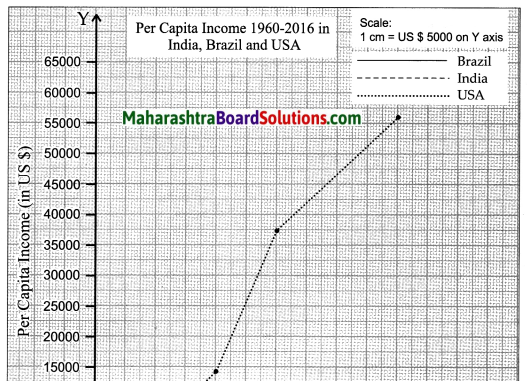

Question 3.
Observe the map of Mining and answer the following questions:
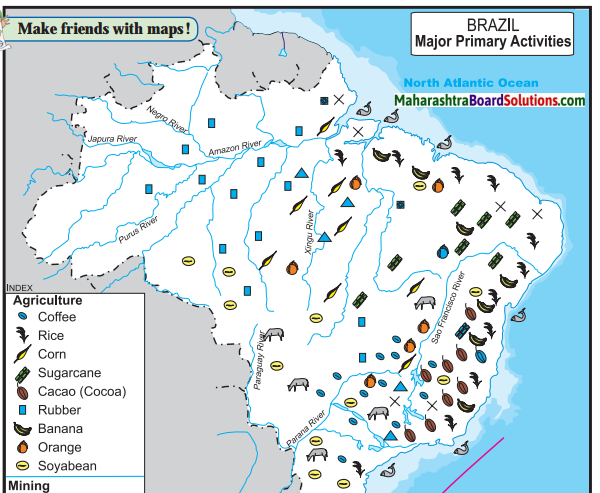

Question (1)
Prepare a table of mining products and regions of production in Brazil.
Answer:
| Mining products | Regions of production in Brazil |
| Manganese | North, east |
| Bauxite | Coastal region |
| Iron-Ore | Central, south-east |
| Coal | South |
Question (2)
In which part of Brazil has mining activity not developed? What could be the reasons?
Answer:
Mining activity has not developed in the western part of Brazil.
Question (3)
Considering the availability of resources, where has the development of industries occurred?
Answer:
Considering the availability of resources development has occurred mainly in the coastal regions of north-east and south-east of Brazil.
![]()
Question 4.
Observe the map of Fishing and answer the following questions:


Question (1)
Can you give two reasons for concentration of fishing near the south-eastern coast of Brazil?
Answer:
Fishing is done on a large scale near the south-eastern coast of Brazil as it is the region where the warm Brazil current and the cold Falkland current meet making the conditions favourable for it to develop as a good fishing ground.
Question (2)
Inland fishing is not developed in Brazil though there are large number of rivers in Brazil. Can you think of a reason?
Answer:
(i) The Amazon River Basin is very vast with a dense growth of equatorial forests, making it largely inaccessible.
(ii) The methods of inland fishing followed are quite traditional and primitive.
These are some of the reasons why inland fishing is not developed in Brazil, though there are large number of rivers.
Question 5.
Observe the logos given and answer the questions.

Question (1)
Identify the industries with which they are associated.
Answer:
(i) Oil and Natural Gas Corporation – Oil and natural gas exploration and production .
(ii) Rashtriya Ispat Nigam Ltd. (RINL) – Steel production.
(iii) Aarey – Dairy and dairy products.
(iv) Chittaranjan Locomotive Works (CLW) – Electric locomotive manufacturing.
(v) Maharashtra Agro Industries Development Corporation (Limited) MAIDC – Production of pesticides, fertilizers, animal feed, agro-engineering (introducing new kinds of farm implements, sale and repair of tractors, harvesters etc.) and processing food (like jams, jellies and sauces).
(vi) Khadi and Village industries Commission
(KVIC)-Establishment and development of khadi and village Industries in rural areas.
(vii) Central Silk Board (CSB) – Silk production.
(viii) Rashtriya Chemical and Fertilizers Ltd. (RCF) Chemical and fertilizer production
![]()
Question (2)
Which raw material is used for these industries. Classify them accordingly.
Answer:
| Classification | Industries | Raw materials |
| Agro-based industries | Maharashtra Agro-industries Development Corporation Ltd. | Seeds, raw materials required for the production of pesticides, fertilisers |
| Khadiand Village Industries Commission | Cotton, silk and wool | |
| Animal product – based industries | Aarey | Milk |
| Central Silk . Board (CSB) | Silk | |
| Minerals and metal-based industries | Oil and Natural Gas Corporation Limited (ONGC) | Crude oil and natural gas |
| Rashtriya Ispat Nigam Ltd. (RINL) | Iron ore and coal | |
| Chittaranjan Locomotive Works (CLW) | Iron and steel and aluminium | |
| Rashtriya Chemical and Fertilizers Ltd. (RCF) | Chemicals and different minerals |
Question (3)
From which part of India do they get these raw materials? Discuss and write.
Answer:
(i) Iron ore, coal, limestone etc.: Chhota Nagpur plateau area of Jharkhand, Odisha, Chhattisgarh, Bengal, Madhya Pradesh, Rajasthan, Karnataka, Goa, Maharashtra etc.
(ii) Natural Gas: Krishna-Godavari Basin.
Mumbai High, in Arabian Sea.
(iii) Mineral Oil: Mumbai High in Arabian sea, Digboi in Assam, Ankleshwar in Gujarat.
(iv) Milk: Bihar, Tamil Nadu, Haryana, Maharashtra, Punjab, Gujarat etc.
(v) Cotton: Gujarat, Maharashtra, Telangana, Karnataka, Andhra Pradesh.
(vi) Silk: Karnataka, Andhra Pradesh, Tamil Nadu, West Bengal, Jammu and Kashmir.
Think about It
Question 1.
Which type of occupations gives a boost to the development of a country’s economy?
Answer:
Secondary and tertiary occupations give a boost to the development of a country’s economy.
Make Friends With Maps
Look at the map given in Fig. The major primary occupations in Brazil are shown here. Discuss the following points and write your observations.


Question 1.
In which part of Brazil is coffee mainly produced?
Answer:
Coffee is mainly produced in the South and South-east part of Brazil.
Question 2.
Which food crops are mainly produced in Brazil?
Answer:
Rice, soyabean and corn are the food crops mainly produced in Brazil.
Question 3.
Can you relate the production of these crops with the climate there?
Answer:
- Brazil has a wide range of climatic variation.
- Rice requires hot and humid climate with heavy rainfall. So it is grown in the coastal region.
- Corn grows well in the central parts of Brazil, because the climate there is hot and dry.
Question 4.
Where are the rubber plantations concentrated?
Answer:
The rubber plantations are concentrated in the north western part in the Amazon River Basin area.
![]()
Question 5.
Complete the table.
Answer:
| Types of crops | Crops | Areas of Prodution |
| Food crops | Corn / Maize | Central |
| Rice | coastal region | |
| Cash crops | Coffee | South east |
| Sugarcane | Central, East | |
| Cocoa | East | |
| Rubber | North | |
| Soyabean | South | |
| Fruits and Vegetables | Bananas | coastal region. |
| Oranges | East, Central |
Note : Areas of the production Each one has a different area. Difficult to point out one area for all the varieties of cash crops, food crops and rice.
Use Your Brain Power
Question 1.
If Rajasthan does not have a coastal area, then how does it produce salt?
Answer:
(i) Rajasthan does not have a coastline, but it still produces salt because of the Sambhar Lake, which is India’s largest inland salt lake.
(ii) Salt is produced on a large scale here due to high proportion of salt in Sambhar Lake and high rate evaporation.
Colours Of Both
Question 1.
Indo-Brazil ties: Answer the following.
Question (1)
What does BRICS stand for?
Answer:
BRICS stands for Brazil, Russia, India, China and South Africa.
Question (2)
When was it established?
Answer:
BRIC was established in June 2006. South Africa was inducted in 2010. Then it became BRICS.
Question (3)
What are the objectives of this bloc?
Answer:
The main objectives of BRICS are:
- To achieve regional development.
- To act as a bridge between developed and developing countries by providing financial assistance and support in various infrastructure projects.
Question (4)
The countries of which continent are not a member of this bloc?
Answer:
The countries of North America and Australia are not a member of this bloc.
Question (5)
In which continents do the member countries lie?
Answer:
The member countries lie in the continents of Europe, South America, Africa and Asia.
Question 2.
Study the graphs and answer the following questions on
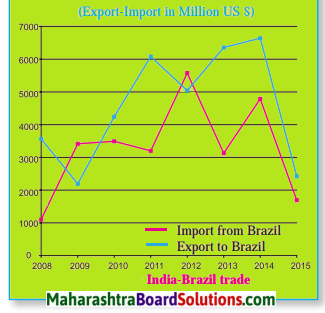
![]()
Question (1)
In which years did the value of exports to Brazil exceed the imports from Brazil?
Answer:
In the years 2008, 2010, 2011, 2013, 2014 and 2015 the value of exports to Brazil have exceeded the imports from Brazil.
Question (2)
In which year was trade with Brazil the most favourable of all?
Answer:
Trade with Brazil was most favourable in the year 2013.
Question (3)
Comment upon the Balance of Trade in the year 2013.
Answer:
(i) The value of Balance of Trade between India and Brazil was maximum in the year 2013.
(ii) Also, the Balance of Trade was in India’s favour.
Question (4)
From which year the value of exports to Brazil have exeeded the value of import from Brazil?
Answer:
From 2010 to 2015 (except 2012).
Question (5)
Write a note on the trade between Brazil and India.
Answer:
(i) Trade between India and Brazil has not been consistent.
(ii) Most of the time the trade has been favourable for India, with exports more than imports.
(iii) In 2015, India-Brazil trade has shown a downfall with both imports and exports at an all-time low.
Question (6)
In which year was the value of exports to Brazil the maximum?
Answer:
The value of exports to Brazil was the maximum in 2014.
Give It A Try
Question 1.
The following images are related to agricultural activities. Identify and write whether they are practised in Brazil or India.
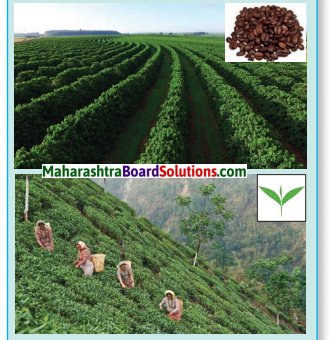
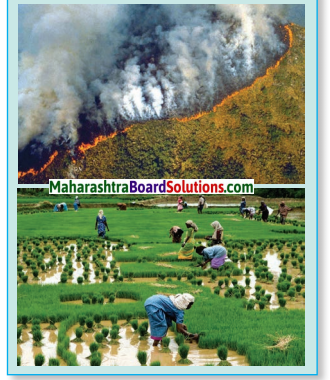
Answer:
(i) In the first image, coffee plantation is seen. It is found mainly in Brazil. In India, coffee plantation are seen in the South Indian states of Karnataka, Kerala and Tamil Nadu.
(ii) The second image is of the Tea plantation. It is mainly found in India, in Assam, West Bengal, Tamil Nadu and Kerala.
(iii) In the third image, shifting agriculture is seen. It is also called ‘Slash and Burn’ agriculture. In this method, the land under forests is cleared by cutting and burning. On this patch of land, subsistence type of agriculture is practised for the next few years.
Once this patch of land loses fertility; another patch of land is brought under shifting cultivation. It is mainly practiced in Brazil and in some parts of India.
In the fourth image, paddy cultivation is seen and it is mainly practiced in India where there is heavy sufficient and irrigation rainfall.
Try This
Question 1.
Show the distribution of crops like wheat, jowar, rice, cotton, sugarcane, tea, jute, coffee and rubber, apple in the outline map of India using symbols. Name the map.
Answer:
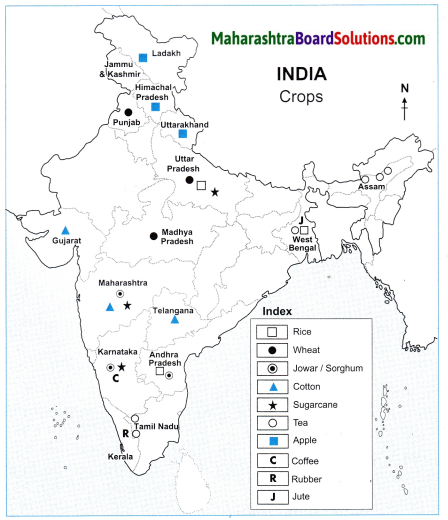
Find Out
Question 1.
Obtain information regarding pisciculture in India with the help of internet and reference books and write a note.
Answer:
- Breeding, rearing and transplantation of fish by artificial means is called pisciculture. It is also called fish farming.
- Fishes are raised in tanks or enclosures for commercial reasons.
- Pisciculture in India is increasing rapidly due to the increasing demand for fish and fish products.
- Indian climate is suitable for practising pisciculture. Wide variety of fish species are raised in the fish farms, e.g. salmon, carp, catfish.
- Due to availability of abundant labour and water sources like lakes, ponds, rivers, etc, pisciculture has become easier.
- Employment opportunities are created due to pisciculture.
- Banks offer loans for those interested in this business.
![]()
Class 10 Geography Chapter 8 Economy and Occupations Additional Important Questions and Answers
Choose the correct option and rewrite the statements:
Question 1.
India has a/an ________ national income as Compared to Brazil.
(a) higher
(b) lower
(c) equal
(d) very low
Answer:
(a) higher
Question 2.
In Brazil, ______ is the main occupation of the people living in the highlands and coastal areas.
(a) agriculture
(b) mining
(c) animal rearing
(d) sericulture
Answer:
(a) agriculture
Question 3.
The main cereal crops grown in Brazil are ______ and maize.
(a) wheat
(b) barley
(c) oat
(d) rice
Answer:
(d) rice
Question 4.
Production of maize is largely concentrated in the _____ part of Brazil.
(a) western
(b) northern
(c) southern
(d) central
Answer:
(d) central
Question 5.
Brazil is the largest exporter of coffee and ______ in the world.
(a) rubber
(b) cocoa
(c) soyabean
(d) maize
Answer:
(c) soyabean
Question 6.
The major states growing coffee are _______ and Sao Paulo.
(a) Rio de Janeiro
(b) Minas Gerais
(c) Para
(d) Parana
Answer:
(b) Minas Gerais
Question 7.
Coffee farms are called _____ in Brazil
(a) para
(b) fazendas
(c) Cerrado
(d) Savannah
Answer:
(b) fazendas
Question 8.
Cattle, sheep and goats are reared in the _____ of the South of Brazil.
(a) Amazon Basin
(b) Parana River basin
(c) Savannah grasslands
(d) Coastal areas
Answer:
(c) Savannah grasslands
Question 9.
The eastern part of Brazil is rich in various types of _____.
(a) crops
(b) animals
(c) minerals
(d) forests
Answer:
(c) minerals
Question 10.
Inaccessibility, lack of knowledge of ________ potential reserves, dense forests are factors which have led to limitation in in the interior parts of Brazil.
(a) agriculture
(b) mining
(c) agro- forestry
(d) fishing
Answer:
(b) mining
Question 11.
Due to the increasing demand in the country, mining has developed well in the ______ region of Brazil.
(a) coastal
(b) highland
(c) mountainous
(d) equatorial forest
Answer:
(b) highland
![]()
Question 12.
Brazil has a sea coast of around 7,400 km and excellent fishing grounds off the ____ coast.
(a) South Atlantic
(b) North Atlantic
(c) South Pacific
(d) North Pacific
Answer:
(a) South Atlantic
Question 13.
The meeting of the warm Brazil current and the cold Falkland current off the coast of South-east Brazil make it a good ______.
(a) fishing ground
(b) offshore oil rig
(c) ocean transport route
(d) fishermen’s settlement
Answer:
(a) fishing ground
Question 14.
Traditionally, in Brazil, fishing has been carried on by small groups of individual fishermen using _____ techniques and equipment.
(a) scientific
(b) modern
(c) primitive
(d) latest
Answer:
(c) primitive
Question 15.
The fish resources of the _____ river are not exploited much and fishing only takes place on a small scale.
(a) Parana
(b) Sao Francisco
(c) Paraguay
(d) Amazon
Answer:
(d) Amazon
Question 16.
Around 60% of land in India is under ________.
(a) cultivation
(b) industries
(c) forestry
(d) mining
Answer:
(a) cultivation
Question 17.
Indian agriculture is mainly _______ type.
(a) commercial
(b) mechanized
(c) subsistence
(d) extensive
Answer:
(c) subsistence
Question 18.
In the coastal areas of India, ______ forms an important part of the diet of many people.
(a) wheat
(b) fish
(c) lobsters
(d) millets
Answer:
(b) fish
Question 19.
Horse mackerels, clupeids and silver bellies are important varieties of ________
(a) crops
(b) fish
(c) millets
(d) cereals
Answer:
(b) fish
Question 20.
Among the freshwater varieties of fish, _______ is a major one.
(a) Sardines
(b) Mackerel
(c) Bombay Duck
(d) Silver Bellies Carp (Chopda)
Answer:
(d) Silver Bellies Carp (Chopda)
Question 21.
In India, the _____ plateau is a big store house of minerals.
(a) Malwa
(b) Bundelkhand
(c) Baghelkhand
(d) Chhota Nagpur
Answer:
(d) Chhota Nagpur
Question 22.
Coal is mined in ____ in Chhattisgarh and in eastern Maharashtra.
(a) Korba
(b) Cuddapah
(c) Digboi
(d) Kalol
Answer:
(a) Korba
Question 23.
Mineral oil wells are found in _____ in Assam.
(a) Korba
(b) Koyali
(c) Digboi
(d) Kalol
Answer:
(c) Digboi
Question 24.
Reserves of mineral oil and natural gas have been discovered at the mouth of the river _______.
(a) Krishna
(b) Kaveri
(c) Godavari
(d) Mahanadi
Answer:
(c) Godavari
Question 25.
Stones like marble are found in Rajasthan and Cuddapah in ______.
(a) Andhra Pradesh
(b) Arunachal Pradesh
(c) Himachal Pradesh
(d) Uttar Pradesh
Answer:
(a) Andhra Pradesh
Question 26.
Traditionally, the poorest part of Brazil is the ______.
(a) north-east
(b) south
(c) north-west
(d) central
Answer:
(a) north-east
![]()
Question 27.
The north-eastern part of the Indian Peninsula has a very high concentration of _____ industries.
(a) chemical
(b) metallurgical
(c) canning
(d) fruit processing
Answer:
(b) metallurgical
Question 28.
The coastal belt of _______ has a heavy concentration of coir, copra and fish canning industries.
(a) Kerala
(b) Goa
(c) Karnataka
(d) Maharashtra
Answer:
(a) Kerala
Question 29.
Many refineries are situated close to the petroleum producing areas whereas Mathura and _______ refineries are in the interior, away from the oil producing areas.
(a) Digboi
(b) Bongaigaon
(c) Barauni
(d) Koyali
Answer:
(c) Barauni
Question 30.
Among the minerals, Brazil mainly exports _____.
(a) coal
(b) gold
(c) iron ore
(d) manganese
Answer:
(c) iron ore
Question 31.
The main trading partner of Brazil among the Gulf countries is _______.
(a) Bahrain
(b) Saudi Arabia
(c) Kuwait
(d) Iran
Answer:
(b) Saudi Arabia
Question 32.
India’s major trading partners from the continent of Europe are the UK and _______.
(a) Italy
(b) France
(c) Germany
(d) Greece
Answer:
(c) Germany
Match the columns:
Question 1.
| S.No | Column ‘A’ | Column ‘B’ |
| (1) | Rice and maize | (a) Commercial crops of Brazil |
| (2) | Tea and mangoes | (b) Cereal crops of Brazil |
| (3) | Cotton and jute | (c) India’s imports |
| (4) | Coffee, cocoa, rubber,soyabean | (d) India’s exports (e) India’s cash crops |
Answer:
1 – b
2 – d
3 – e
Question 2.
| Column ‘A’ | Column ‘B’ |
| (1) Kachchh | (a) Kerala |
| (2) Coromandal coast | (b) North east India |
| (3) Malabar coast | (c) Near Maharashtra |
| (4) Mumbai High | (d) South east India (e) Western coast |
Answer:
1 – e
2 – d
3 – a
4 – c
Question 3.
| Column ‘A’ | Column ’B’ | Column ‘C’ |
| (1) Coal | (a) Digboi | (i) Andhra Pradesh |
| (2) Mineral oil well | (b) Coastal belt | (ii) Chhattisgarh |
| (3) Stones | (c) Korba | (iii) Kaveri |
| (4) Mineral oil and Natural gas | (d) River mouth | (iv) Assam |
| (5) Coir and copra | (e) Cuddapah | (v) Godavari |
| (f) Estuary | (vi) Kerala |
Answer:
1 – c – ii
2 – a – iv
3 – e – i
4 – d – v
5 – b – vi
![]()
Question 4.
| Column ‘A’ | Column ‘B’ |
| (1) Coir, copra and fish canning | (a) Mathura |
| (2) Salt | (b) Gujarat |
| (3) Oil refineries | (c) Kerala |
| (4) Stones | (d) Barauni |
| (e) Andhra Pradesh |
Answer:
1 – c
2 – b
3 – d
4 – e
Answer the following in one sentence:
Question 1.
Which currency is mainly used for international trade?
Answer:
US dollar is the currency which is mainly used for international trade.
Question 2.
Name the sectors of Brazil in which Indian companies have invested money.
Answer:
Information technology, pharmaceuticals, energy, agro-business, mining, engineering, automobiles, etc. are the sectors of Brazil in which Indian companies have invested money.
Question 3.
Name the sectors of India in which Brazilian companies have invested money.
Answer:
Automobiles, information technology, mining, energy, bio-fuel, footwear, etc. are the sectors of India in which Brazilian companies have invested capital.
Question 4.
Which type of occupations give a boost to the development of a country’s economy ?
Answer:
Tertiary occupation give a boost to the development of a country’s economy.
Name the following:
Question 1.
Factors making it possible for growing a variety of crops in Brazil.
Answer:
Favourable climate and topography.
Question 2.
The main cereal crops of Brazil.
Answer:
Rice and maize
Question 3.
The production of this cereal crop is largely concentrated in the central part of Brazil.
Answer:
Maize.
Question 4.
The major commercial crops of Brazil.
Answer:
Coffee, cocoa, rubber, soyabean and sugarcane.
Question 5.
The largest exporter of coffee and soyabean in the world.
Answer:
Brazil.
Question 6.
The major coffee-growing states of Brazil.
Answer:
Minas Gerais and Sao Paulo.
Question 7.
Fruits are grown in Brazil.
Answer:
Bananas, pineapples, oranges and other citrus fruits.
Question 8.
The region in Brazil where cattle, sheep and goats are reared.
Answer:
Savannah grasslands in the south.
Question 9.
Two factors that have led to limitations in mining in the interior parts of Brazil.
Answer:
- Inaccessibility due to dense forests
- Lack of knowledge of potential reserves of resources.
![]()
Question 10.
The warm current in the eastern coast of Brazil.
Answer:
Brazil current.
Question 11.
The cold current off the south-eastern coast of Brazil.
Answer:
Falkland current.
Question 12.
The main catches of the fishermen in Brazil.
Answer:
Swordfish, shrimp, lobsters, sardines, etc.
Question 13.
Major food crops produced in India.
Answer:
Rice, wheat, maize, sorghum and millets.
Question 14.
Crops grown in plantation in India.
Answer:
Tea, coffee and rubber.
Question 15.
Major cash crops grown in India.
Answer:
Sugarcane, cotton and jute.
Question 16.
Main type of Indian agriculture.
Answer:
Subsistence.
Question 17.
Maj or fish varieties found in the western coastal region of India.
Answer:
Sardines, mackerel, bombay duck and prawns.
Question 18.
The important varieties of fish on the eastern coast of India.
Answer:
Horse mackerels, clupeids and silver bellied carp.
Question 19.
The major freshwater fish variety in India.
Answer:
Silver bellied carp (chopda).
Question 20.
Places where coal is mined in India.
Answer:
Korba in Chhattisgarh and in Eastern Maharashtra
Question 21.
Places where mineral oil wells are found in India.
Answer:
(i) Digboi in Assam
(ii) Mumbai High in the Arabian Sea near Maharashtra
(iii) Kalol and Koyali in Gujarat.
Question 22.
The name of the river mouth, where reserves of mineral oil and natural gas have been discovered.
Answer:
River Godavari.
Question 23.
The state where stones like marble are found.
Answer:
Rajasthan.
Question 24.
The place/state where stones like Cuddapah are found.
Answer:
Cuddappah in Andhra Pradesh.
Question 25.
The states in which fish forms an important part of the diet of many people living in the coastal areas in India.
Answer:
Kerala, West Bengal, Odisha, Andhra Pradesh, Tamil Nadu, Goa and Maharashtra.
![]()
Question 26.
States of India where metallic minerals are found.
Answer: Jharkhand, Odisha, adjoining Chhattisgarh and Madhya Pradesh, parts of Rajasthan, Karnataka and Tamil Nadu.
Question 27.
The agro-based industries in India which are heavily concentrated in the raw material- producing areas.
Answer:
Cotton, jute and sugar.
Question 28.
The forest-based industries in India.
Answer:
Paper, plywood, matches, resins and lac.
Question 29.
Industries found in the coastal belt of Kerala in India.
Answer:
Coir, copra and fish canning.
Question 30.
Refineries in India situated close to the petroleum-producing areas.
Answer:
Koyali, Digboi, Noonmati and Bongaigaon.
Question 31.
Refineries in India located away from the coast and oil-producing areas.
Answer:
Mathura and Barauni.
Question 32.
Major salt-producing states in India.
Answer:
Gujarat, Rajasthan and Tamil Nadu.
Question 33.
Brazil’s export items.
Answer:
Iron ore, coffee, cocoa, cotton, sugar, tobacco, oranges and bananas.
Question 34.
Brazil’s import items.
Answer:
Machinery, chemical products, fertilizers, wheat, heavy vehicles, mineral oil and lubricants.
Question 35.
Major trading partners of Brazil.
Answer:
Germany, the USA, Canada, Italy and Argentina, Saudi Arabia.
Question 36.
India’s export items.
Answer:
Tea, coffee, mangoes, spices, leather & leather goods, iron ore, cotton and silk textiles etc.
Question 37.
India’s import items.
Answer:
Petroleum, machines, pearls and precious stones, gold and silver, paper, medicines, etc.
Question 38.
India’s major trading partners.
Answer:
The USA, The UK, Germany, Japan, China, Russia, etc.
Distinguish between:
Question 1.
The Indian companies’ investment in Brazil and Brazil’s investment in India.
Answer:
| Indian investment in Brazil | Brazilian investment in India |
| (i) Indian companies have invested a lot of capital in Brazil. (ii) e.g. IT, pharmaceuticals, energy, agri-business, mining, engineering and auto sectors. |
(i) Brazilian companies investment in India is smaller.(ii) e.g. automobiles, IT, mining, energy, biofuels, footwear sectors in India. |
Question 2.
Brazil-International Trade and India-International Trade
Answer:
| Brazil-International Trade | India-International Trade |
| (i) Major exports of Brazil are iron-ore, coffee, cocoa, cotton, sugar, tobacco, oranges and bananas. (ii) Major imports of Brazil are machinery, chemical products, fertilizers, wheat, heavy vehicles, mineral oil and lubricants. (iii) Major trading partners of Brazil are Germany, the USA, Canada, Italy, Argentina, India and Saudi Arabia. |
(i) Major exports of India are tea, coffee, mangoes, spices, leather and leather goods, iron ore, cotton and silk textiles. (ii) Major imports of India are petroleum, machines, pearls, precious stones, gold and silver, paper, medicines, etc. (iii) Major trading partners of India are the USA, the UK, Germany, Japan, China, Russia, etc. |
Question 3.
US Economy and India-Brazil Economies.
Answer:
| US Economy | India-Brazil Economy |
| (i) The US economy is a developed economy. (ii) National income and per capita income of US is far ahead of Brazil and India. (iii) The US has the strength of many patents, modern technology and mechanical strength. |
(i) India and Brazil are developing economies. (ii) National income and per capita income of India and Brazil is low. (iii)India and Brazil have just about started progressing in the fields of technology, education and industry. |
![]()
Mark the following on the outline map:
Question 1.
On the given Political map of Brazil, show the following details (Draw index).
- Major coffee producing areas of Brazil.
- The cold and warm ocean current near the Brazilian coast.
- Important fishing areas in the Northern coast.
- Important fishing areas in the Eastern coast.
Answer:
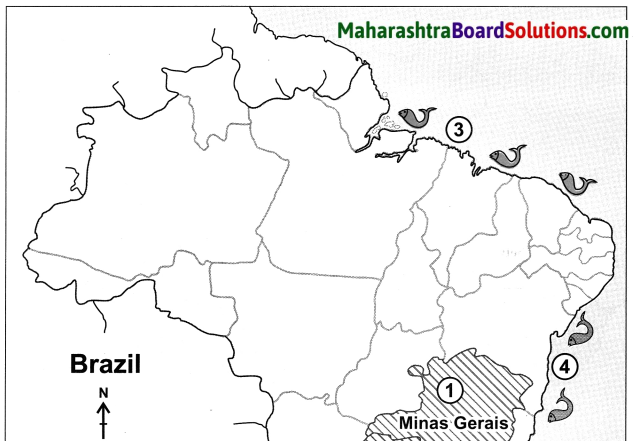
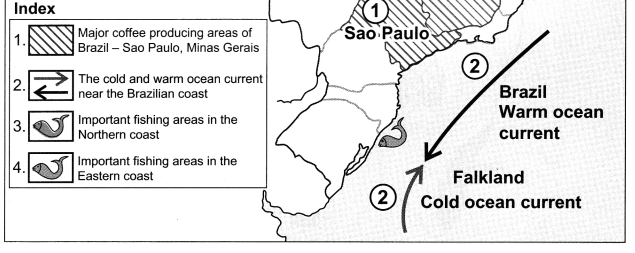
Question 2.
Indicate the following on a map of India.
- The plateau region rich in minerals.
- Region where coal is mined.
- State where marble is found.
- Cudappah stones are found in this state.
- The state whose coastal belt has a concentration of coir, copra and fish canning industries.
- Major salt producing state.
Answer:
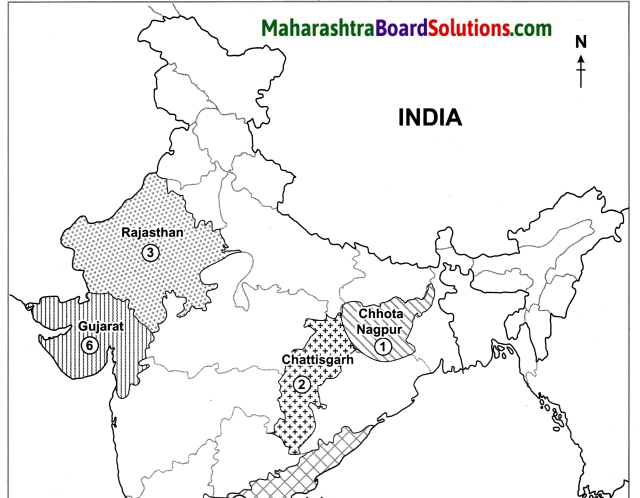
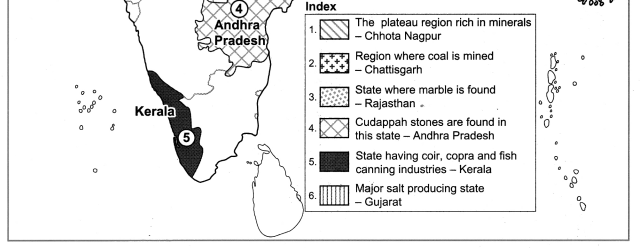
Question 3.
Locate the following regions on the map of India.
- Mineral oil wells.
- Oil refineries close to petroleum producing areas.
- Oil refineries in the interiors.
- The mouth of the river where reserves of mineral oil and natural gas have been discovered.
Answer:
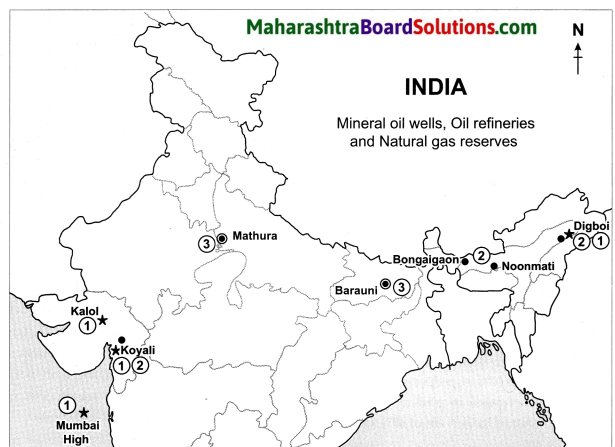
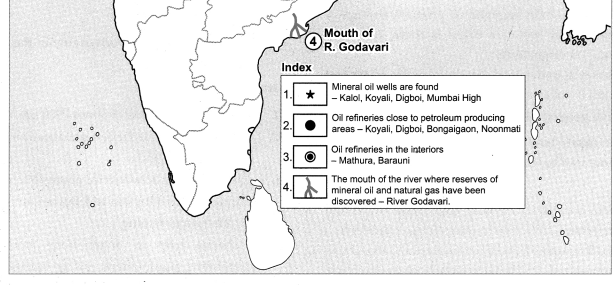
Give Geographical Reasons:
Question 1.
Unlike Brazil, India’s agriculture contributes more towards the GDP.
Answer:
- Around 60% of land in India is under cultivation.
- Agriculture has been a long standing activity here with a large chunk of population engaged in it.
- The enormous expanse of level plains, rich soils, high percentage of cultivable land, wide climatic variety, long growing season, etc. provide a strong base for agriculture in India.
- So, unlike Brazil, India’s agriculture contributes more towards the GDP.
![]()
Question 2.
Fishing plays an important role in the economy of India.
Answer:
- India has a coastline of about 7500 km.
- India is one of the largest producer of fish, both marine and inland.
- Marine fishing accounts for about 40% of the total annual fish production and the remaining 60% is by freshwater fishing.
- Fisheries help in augmenting food supply, generating employment, raising nutritional level and earning foreign exchange.
- Fish forms an important part of the diet of many people living in all the coastal states.
- Thus, fishing plays a significant role in the economy of the country.
Question 3.
The distribution of industries in India is highly uneven.
Answer:
The distribution of industries is India in highly uneven due to the following reasons:
- Uneven distribution of the necessary raw materials and power resources.
- There is concentration of enterprises, financial resources and other necessary conditions in large towns.
Question 4.
The North Eastern part of the Indian Peninsula has a high concentration of heavy metallurgical industries.
Answer:
The north eastern part of the Indian Peninsula has a high concentration of heavy metallurgical industries because:
- Chattisgarh, Odisha, Jharkhand, West Bengal are rich in minerals.
- Large quantities of coal deposits, an important raw material in metallurgical industries is available.
- There are availability of refractory materials, cheap power from the Damodar Valley Corporation and a number of thermal power projects.
- There is availability of cheap labour in and around this region.
Question 5.
USA is a developed country.
Answer:
The United States is a developed country because:
- This country has less but a well-educated population.
- It has the strength of many patents, modern technology and mechanical strength.
- USA has a very high national income and per capita income.
Question 6.
Brazil is a good fishing ground.
Answer:
Brazil is a good fishing ground because :
- Brazil has a sea coast of around 7400 km and excellent fishing grounds off the South Atlantic coast.
- The meeting of the warm Brazil current and the cold Falkland current off the coast of South-East Brazil makes it a good fishing ground.
Write short notes on:
Question 1.
Mining in India:
Answer:
(i) The Chhota Nagpur plateau in India is a big storehouse of different minerals. Mining is the main occupation of the people.
(ii) Coal is mined in Korba in Chattisgarh and in Eastern Maharashtra.
(iii) Mineral oil wells are found in Digboi in
Assam, Mumbai High in the Arabian Sea near Maharashtra, Kalol, Koyali in Gujarat.
(iv) Stones like marble are found in Rajasthan and Cuddapah in Andhra Pradesh.
Question 2.
Industries in Brazil:
Answer:
(i) Major industries of Brazil are iron and steel, automobile assembling, petroleum processing, chemical production and cement making.
(ii) Technologically based industries have been the most dynamic in recent years.
(iii) Food-processing industries, cotton textiles, silk and woollen industries have developed well.
(iv) Most large industries are concentrated in the south and south-east of Brazil.
Question 3.
Agro-based and forest-based industries in India.
Answer:
(i) Agro-based industries: The agro-based industries including cotton, jute and sugar are heavily concentrated in the raw material producing areas.
(ii) Forest-based industries: The forest based industries including paper, plywood, matches, resins and lac are increasingly finding mostly found in the forest areas of various states.
10th Std Geography Questions And Answers:
- Field Visit Class 10 Geography Questions And Answers
- Location and Extent Class 10 Geography Questions And Answers
- Physiography and Drainage Class 10 Geography Questions And Answers
- Climate Class 10 Geography Questions And Answers
- Natural Vegetation and Wildlife Class 10 Geography Questions And Answers
- Population Class 10 Geography Questions And Answers
- Human Settlements Class 10 Geography Questions And Answers
- Economy and Occupations Class 10 Geography Questions And Answers
- Tourism, Transport and Communication Class 10 Geography Questions And Answers